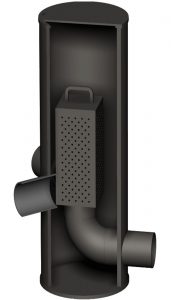In today’s world of increasing urbanisation and unpredictable weather patterns, managing excess rainwater and preventing flooding has never been more crucial. One of the unsung heroes of sustainable drainage systems (SuDS) is vortex flow control—a smart and efficient solution that’s revolutionising the way water is managed across the UK and beyond. But what exactly is vortex flow control, and why should it matter to developers, engineers, and communities?
Let’s break it down in simple terms and explore how this fascinating principle, rooted in fluid dynamics, contributes to energy efficiency, flow regulation, and better drainage performance overall.
Understanding Vortex Flow Control
At its core, vortex flow control uses the principles of vortex generation to manage water flow, particularly in stormwater and sewer systems. Rather than relying on mechanical parts, these systems use the natural spiraling motion of water—created within a specially shaped chamber—to regulate flow rates. This allows excess water to be temporarily held back and released at a controlled pace, reducing the risk of downstream flooding.
The key advantage? Vortex flow control devices are self-activating, requiring no external power, making them both energy-efficient and low maintenance.
Why Vortex Flow Control Is Vital in Sustainable Drainage
Sustainable drainage systems are all about mimicking natural water cycles in built environments. With increasingly frequent and intense rainfall events, traditional drainage systems often fall short. That’s where vortex flow control steps in.
By offering turbulence management and pressure control, vortex devices effectively smooth out the flow of water during peak storm events. This prevents sudden surges that can overwhelm drainage systems and damage infrastructure. It’s an elegant solution that protects urban areas without requiring significant operational intervention.
How It Works: Simplicity Backed by Science
Vortex flow controls typically consist of a cylindrical chamber with a specially designed outlet. When stormwater enters at high speed, it forms a rotating motion—a vortex—within the chamber. This spiral movement creates a low-pressure zone at the center, which limits the outflow rate in a controlled manner.
This design approach is not just about slowing down water. It’s about airflow manipulation, ensuring that air and water interact optimally within the chamber to maintain steady, predictable discharge. This principle shares roots with aerodynamics optimization, where flow is guided intelligently to reduce turbulence and improve performance—very similar to how engineers approach drag reduction in automotive or aerospace design.
Applications in Urban and Commercial Projects
Vortex flow control is already being widely adopted across commercial, residential, and municipal developments. Whether in a car park, industrial estate, or new housing development, these devices are crucial to meeting regulatory requirements for runoff and flood risk management.
Moreover, because they support flow regulation without the need for moving parts, they offer long-term reliability—an important consideration for councils and private developers alike. In circuit-based drainage networks, their ability to stabilise flows makes them a smart choice for engineers focused on circuit design and system longevity.
The Free Flush Advantage
UK-based brand Free Flush has been at the forefront of water-saving and sustainable drainage innovations. The company champions environmentally friendly solutions like vortex flow control that align with today’s sustainability goals. With a commitment to innovation and cost-effective design, Free Flush helps clients across the UK integrate smarter drainage into their projects—helping reduce water waste and support long-term energy efficiency.
Comparing Vortex Flow Control with Traditional Methods
Conventional flow regulators often use orifice plates or valves, which can be prone to clogging and require regular maintenance. In contrast, vortex flow control units are virtually self-cleaning. The spiraling water naturally keeps debris moving, making it less likely to accumulate and block the system.
This feature not only reduces operational costs but also boosts reliability during critical moments—such as during a flash flood. For regions with aging infrastructure or limited budgets, this low-intervention solution becomes a game changer.
Design Considerations for Engineers and Planners
For engineers, the integration of vortex flow control devices requires thoughtful planning, particularly when aligning with site gradients, expected flow volumes, and outfall constraints. Factors such as chamber size and outlet configuration can be tailored to optimise fluid dynamics for each location.
This level of adaptability ensures that systems can be fine-tuned for various climates and land uses. Planners looking to reduce the impact of urban development on watercourses can now turn to vortex flow control as a versatile, science-backed solution.
Looking Ahead: A Future Built on Smarter Flow
With growing emphasis on sustainability and climate resilience, vortex flow control is likely to play an even greater role in how cities manage stormwater. Its elegant use of natural forces, lack of power dependency, and high reliability make it a valuable tool in the push toward greener urban development.
As the UK and other countries implement tighter regulations around stormwater discharge, incorporating vortex systems becomes not just a smart choice—but often a necessary one.
Final Thoughts
Vortex flow control may not be the most visible part of a drainage system, but its impact is profound. By embracing the principles of vortex generation, turbulence management, and pressure control, these devices help shape safer, cleaner, and more efficient environments.
For communities, engineers, and forward-thinking brands like Free Flush, it represents a step toward smarter infrastructure—where nature’s own dynamics are harnessed to serve people and the planet.
.jpg)


